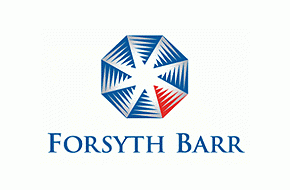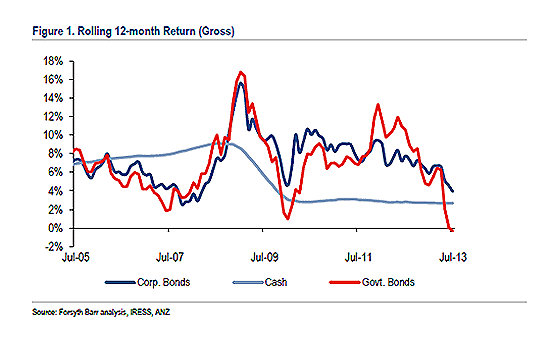
Content supplied by Forsyth Barr
The following is a summary of the key events impacting fixed income markets over the past week.
By the end of Tuesday most of the worlds’ central banks will have disclosed their current thoughts on their respective economies. The Reserve Bank of Australia (RBA) holds its monthly meeting on Tuesday while the European Central Bank (ECB), the Fed and Bank of England (BoE) met last week.
Central bank outlooks remain mixed
There is becoming some divergence in Central Bank monetary policy with the recent round of Central Bank meetings. We saw the hawkish tone set by our own Reserve Bank of New Zealand (RBNZ), while the comments from RBA Governor, Glenn Stevens, suggest that the RBA is close to lowering its cash rate. National Australia Bank recently moved to match the rest of the market calling for at least one -25bp cut and one further cut before the end of 2013.
The story in the Northern Hemisphere is similar with the Fed buoyed by strong economic data (including a four year low unemployment rate, see below) while in Europe the ECB and BoE remain accommodative. The ECB said interest rates would remain low for an “extended period”.
BoE’s new governor Mark Carney will make his first public comments on Britain's economy since taking charge of the central bank on Wednesday which is expected to be "… a big market-moving event" according to one analyst.
The RBNZ remains the outcast with one +25bp hike priced in for the March 2014 meeting and an 80% chance of a +25bp hike at the January 2014 meeting. Overall two hikes to the current 2.50% Official Cash Rate are priced in by the end of April 2014.
Credit markets tighten across the globe
Credit markets in both the US and Australia tightened by -4bp over the course of the week, whereas European credit spreads contracted by -7bp. In New Zealand, the yield on the ANZ Investment Grade Index rose by +7bp last week to close at 4.70%.
Inflation-indexed bond overbid
The New Zealand Debt Management Office (DMO) sold NZ$300m of the September 2025 Inflation-Indexed Government Bond after receiving NZ$683m worth of bids. The bonds were sold at a weighted average yield of 2.3204%.
US unemployment falls
The widely anticipated non-farm payrolls data released at the end of last week provided a mixed bag. The market had been expecting 184,000 new jobs in June however, the 162,000 disappointed along with a -26,000 revision lower of May’s data. This disappointment was somewhat offset by the unemployment rate falling from 7.6% to 7.4%.
This key economic indicator is going to be even more heavily scrutinised in the next few months as the market looks for signs that the magical 7% is within grasp. The 7% level is where there is ‘broad support’ among the Fed for shutting down its US$85bn bond-buying programme.
The end or a wind-down of the bond buying programme will see interest rates begin to rise again and New Zealand long-term interest rates will likely follow suit.
Local Authority bonds replace bank bonds
The return on the ANZ Investment Grade Bond Index was once again negative for the month of July (see graph below). The yield on the index continues to climb higher up +20bp to 4.70% at 31 July and +61bp at 31 May 2013.The +20bp rise in July was consistent with the underlying swap rates which posted rises of +17bp at the long-end, +26bp at the five-year and +17bp at the short-end of the curve.
The market continues to firmly believe that the Official Cash Rate (OCR) will increase in the first quarter of 2014. These beliefs along with an improving economic scene in the US have put pressure on the long-end of the curve. If and when the OCR begins to rise, it is likely that the New Zealand swap curve will begin to flatten as short-term interest rates begin to rise.
The yield curve has already flattened by around -9bp over the month of July due to the expectations that the Reserve Bank of New Zealand will need to raise the OCR sooner than it had originally forecast.
The duration of the ANZ Investment Grade Bond Index continues to be quite short at 2.8 years and is consistent with our own recommendation that fixed income portfolio duration be around 3 years. The short duration call will benefit fixed income portfolios as interest rates begin to rise.
One of the features of the index is the changing of its constituents. At this time last year, 50% of the index was made up of bank issuance. As at 31 July 2013, bank issuance has fallen by -6% to 44% with issuance from the Local Government Funding Agency (LGFA) rising by +8%. Debt issuance from the Local Authorities now makes up 22% of the total index.
This is a trend which is likely to continue as the LGFA continues to expand and banks being very well funded via its retail deposit base as opposed to the retail bond market.
The 16% of total issuance contribution from the corporate sector was unchanged from a year ago but unfortunately it is not growing despite being able to issue bonds to an issuance starved retail investor base at some attractive issue yields.
The returns on New Zealand Government Bonds are likely to remain a touch volatile as their close correlation with the US means NZGB’s will also be subject to market gyrations around US economic data.

Corporate / Credit news
Auckland International Airport (AIA) received a big tick from the Commerce Commission, with the Commission confirming that AIA was not generating excessive profits. This outcome significantly reduces the regulatory risk surrounding AIA.
Fonterra continues to grab the spotlight with another profit warning. Fonterra recently warned on its FY13 profit outlook the previous week and has now warned on FY14. The higher Forecast Farmgate Milk Price announced last week, from NZ$7.00 to NZ$7.50, means higher cost of goods sold which negatively impacts earnings.
Infratil (IFT) confirmed that its convertible Infrastructure bonds maturing on 15 September 2013 will be redeemed for cash at maturity and not converted into shares in Infratil.
The Local Government Funding Agency (LGFA) held tender number 14 last week where it sold NZ$10m of April 2015’s and NZ$185m of May 2021’s. Demand once again exceeded supply with the April 2015’s sold at a yield of 3.45% and the May 2021’s sold at a yield of 5.03%.
Meridian Energy (MEL) released its operating information for the three months ended 30 June 2013. MEL’s retail customer connections fell by -15,227 versus the prior quarter comparative to 272,077.
The NZX released its monthly operating statistics for July. Over the year to 31 July the number of listed debt securities fell -25% with total trades on the NZDX falling -1.6% versus the pcp. The value of those trades also fell -22%. Year-to-date the amount of debt raised is NZ$93m versus NZ$1,596m on the primary equity market.
TOWER confirmed the unconditional sale of its Life business with a settlement date to be released soon. It is then expected that TOWER will provide TWC010 holders with the required 45 business days of early redemption.
----------------------------------------------------
Disclosures and Disclaimers:
Disclosure: The comments in this publication are for general information purposes only. This publication is not intended to constitute investment advice under the Securities Markets Act 1988. If you wish to receive specific investment advice, please contact your Investment Advisor. Forsyth Barr Limited and its related companies (and their respective officers, agents and employees) may own or have an interest in securities or other products referred to in this publication, and may be directors or officers of, or provide investment banking services to, the issuer of those securities or products, and may receive fees for acting in any such capacity in relation to that issuer. Further, they may buy or sell securities as principal or agent, and as such may undertake transactions that are not consistent with any recommendations contained in this publication. Forsyth Barr Limited and its related companies (and their respective officers, agents and employees) confirms no inducement has been accepted from the researched/recommended entity, whether pecuniary or otherwise, in connection with making any recommendation contained in this publication or on our website.
Analyst Disclosure Statement: In preparing this publication the analyst(s) may or may not have a threshold interest in the securities mentioned in this publication. A threshold interest is defined as being a holder of more than $50,000 or 1% of the securities on issue, whichever is the lesser. In preparing this publication non-financial assistance may have been provided by the entity being researched. A disclosure statement is available on request and is free of charge.
Disclaimer: This publication has been prepared in good faith based on information obtained from sources believed to be reliable and accurate. However, that information has not been independently verified or investigated by Forsyth Barr Limited. Accordingly, Forsyth Barr Limited: (a) does not make any representation or warranty (express or implied) that the information is accurate, complete or current; and (b) excludes and disclaims (to the maximum extent permitted by law) any liability for any loss which may be incurred by any person as a result of that information being inaccurate or incomplete in any way or for any reason. The information, analyses and recommendations contained in this publication are confidential to the intended recipients and are statements of opinion only. They have been prepared for general information purposes and whilst every care has been taken in their preparation, no warranty or representation is given (express or implied) as to their accuracy or completeness. Nothing in this publication should be construed as a solicitation to buy or sell any security or other product, or to engage in or refrain from doing so or engaging in any other transaction. This publication should not be used as a substitute for specific advice. This publication is intended to provide general securities advice only, and has been prepared without taking account of your objectives, financial situation or needs, and therefore prior to acting on any information, analysis or recommendation contained in this publication, you should seek advice from your usual Investment Advisor. Forsyth Barr Limited and its related companies (and their respective officers, agents and employees) will not be liable for any loss whatsoever suffered by any person relying upon any such information, analysis or recommendation. This publication is not intended to be distributed or made available to any person in any jurisdiction where doing so would constitute a breach of any applicable laws or regulations.
1 Comments
Why would the RBNZ be looking to raise rates while all other central banks around the world are lowering them (like AUS), or printing massive amounts of money like the UK, USA and Japan? Inflation here looks to be under the target band, so what is the justification for a hike in rates?
I think they are too focused on AKL house prices and not the broader economy and world economic outlook. Ironically keeping rates low might ease house prices as it would encourage developers to borrow money to build more houses. Their job should be to control inflation first and foremost.
We welcome your comments below. If you are not already registered, please register to comment.
Remember we welcome robust, respectful and insightful debate. We don't welcome abusive or defamatory comments and will de-register those repeatedly making such comments. Our current comment policy is here.